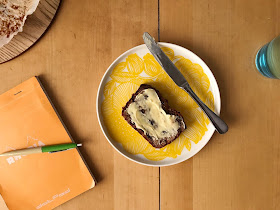Nora Ephron was a writer. Though she wasn't a food writer, all of her work, in one way or another, features food - from her screen adaptation of Julie and Julia (about how Julia Child became Julia Child), to perhaps her most-well known script When Harry Met Sally (whose most memorable scene takes place in Katz's Deli) to an early novel of hers I read just a few weeks ago, titled - memorably, perfectly - Heartburn. The book is the account of a marriage ending. Its heroine is a food writer who discovers her Washington journalist husband is having an affair while she is pregnant with their second child. It's funny, it's heartbreaking, it has recipes. Just like life.

To all those people who think making pie is hard (and that includes me), this recipe is for you. It's so simple, it's not even written in recipe form in the book, just unfolds in a few sentences. And in actuality, it really is that easy. No need for rolling pins, resting times, or chopping more than three pieces of fruit, it really is a marvel. Ephron's heroine makes hers at a lake house in West Virginia over summer, a time you're so hot and lazy you really can't be bothered to cook at all. It's the sort of thing that is perfect holiday house food - no need for fancy ingredients, or heavy reliance on an unfamiliar oven. The crust is crisp and buttery, the filling oozy and extravagant with the juicy sweetness of ripe peaches. Nora knows her stuff.

Heartburn is said to be a thinly veiled account of the end of Ephron's own marriage - to Washington Post journalist Carl Bernstein, memorably portrayed by Dustin Hoffman in All The President's Men. Heartburn itself was made into a film in 1986, with Meryl Steep and Jack Nicholson, and is every bit as delicious as this pie.
Though she'd achieved so much in her career, Nora Ephron died too soon in 2012. She is survived by her husband, writer/producer Nick Pileggi, and her two sons, Jacob and Max. In addition to her screenplays and novels, she wrote a lot of essays. In one - much earlier in her life - she reflected on dying and, as ever, came back to food. The New York Times included it in her obituary of June 26, 2012:
Ms.
Ephron’s collection “I Remember Nothing” concludes with two lists, one
of things she says she won’t miss and one of things she will. Among the
“won’t miss” items are dry skin, Clarence Thomas, the sound of the vacuum cleaner, and panels on “Women in Film.” The other list, of the things she will miss, begins with “my kids” and “Nick” and ends this way:
“Taking a bath
Coming over the bridge to Manhattan
Pie.”
Nora Ephron's peach pie
From Heartburn by Nora Ephron, first published in 1983
I am going to just print the recipe exactly as it appears in the novel because it is perfect. A Cuisinart is a brand of food processor. Any will do. Only when transcribing the recipe did I see that it called for the peaches to be peeled. I didn't do that and was so pleased with my pie I couldn't imagine it could be any better. I'm sure Nora would approve of my minor (unconscious) adaptation.
Last summer they came to visit us in West Virginia and Julie and I spent a week perfecting the peach pie. We made ordinary peach pie, and deep dish peach pie, and blueberry and peach pie, but here is the best peach pie we made: Put 1 1/4 cups flour, 1/2 teaspoon salt, 1/2 cup butter and 2 tablespoons sour cream into a Cuisinart and blend until they form a ball. Pat out into a buttered pie tin, and bake 10 minutes at 425°. Beat three egg yolks slightly and combine with 1 cup sugar, 2 tablespoons flour and 1/3 cup sour cream. Pour over 3 peeled, sliced peaches arranged in the crust. Cover with foil. Reduce oven to 350° and bake 35 minutes. Remove the foil and bake 10 minutes more, or until filling is set.









































